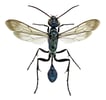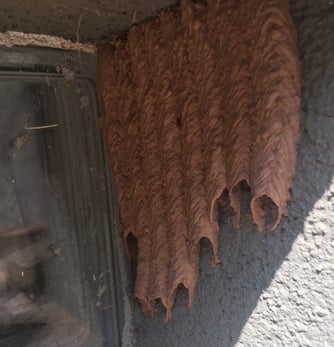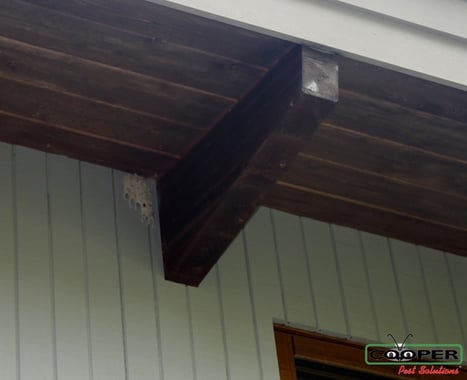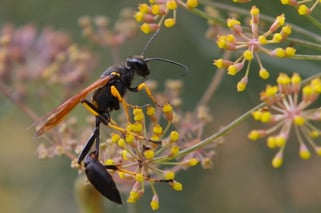Mud Wasp Information For New Jersey & Pennsylvania Residents
 Mud wasps, also referred to as mud daubers, are categorized as stinging insects, much like paper wasps, yellow jackets, and hornets. They appear either blackish-blue or black and yellow. Their defining feature is their thread-like waist which separates them apart from other stinging insects such as paper wasps, hornets, and yellow jackets. They have 6 long, thin legs that hang below their body and 2 antennae. Mud wasps are what is called “solitary wasps,” which is the antonym of “social wasps.” Unlike social wasps like yellow jackets, mud wasps do not live in colonies. If you see a mud wasp around your property, there is no need to worry about a swarm or severe infestation. In terms of human interactions, mud daubers don't typically attack humans. They are fairly docile and could care less about you if you leave them alone.
Mud wasps, also referred to as mud daubers, are categorized as stinging insects, much like paper wasps, yellow jackets, and hornets. They appear either blackish-blue or black and yellow. Their defining feature is their thread-like waist which separates them apart from other stinging insects such as paper wasps, hornets, and yellow jackets. They have 6 long, thin legs that hang below their body and 2 antennae. Mud wasps are what is called “solitary wasps,” which is the antonym of “social wasps.” Unlike social wasps like yellow jackets, mud wasps do not live in colonies. If you see a mud wasp around your property, there is no need to worry about a swarm or severe infestation. In terms of human interactions, mud daubers don't typically attack humans. They are fairly docile and could care less about you if you leave them alone.
What does a mud wasp nest look like?

If you aren't seeing mud wasps flying around or if you are unsure as to what type of wasp you are seeing, nests can give the clues you need. Mud wasp nests either look like organ pipes partitioned off with mud or like someone to a clump of mud and threw it up against a wall. Nests are created by female mud wasps that gather mud from nearby sources. Colors of nests can vary based on what mud is available in the area. Many mud wasps prefer clay. The nests are large enough to host eggs and paralyzed spiders. In most cases, mud daubers will not select the same place to nest between generations. This means current mud wasp activity doesn't necessarily guarantee nest building year after year.
Common nesting sites include under the eaves and soffits on the exterior of homes and buildings as well as under decks and porches. Covered areas that are off of the ground are ideal spots to find mud wasp nests. They construct nests on the surface of the chosen structure rather than hanging from vegetation like hornets. For that reason, you may not notice the nests because they are made in unobtrusive areas.
Why do I have mud wasps?

Mud wasps seek out areas that are rich with small insects. Where there are small insects, there are spiders that feed on them. Mud wasps eat spiders and also bring back to their nest and feed their young. Their nests are made out of mud and dirt that they scrape up around the vicinity of their nest. Mud dauber nests either look like pipes or tubes lined up next to each other, high off of the ground. For the most amount of protection, their nests are built flush against surfaces in areas such as the sides of homes and buildings, under overhangs, and under eaves. Sometimes you will see groupings of mud wasp nests in close proximity. Although the nests can appear in groups, a single female mud wasp will create each nest. Only female mud wasps build nests and hunt for spiders. The males can be seen hovering around flowers, consuming nectar and looking for a mate. Larvae remain in the nest over the winter and hatch in the spring when the weather warms up.
Are mud wasps harmful?

Mud wasps are actually beneficial to your property because they mainly eat spiders, more specifically black widow spiders. Mud wasps find spiders, paralyze them with their venom, and bring them back to their nest for their young to feed on. The stinging power of a mud wasp is solely used on their prey, not as a defense mechanism to protect a colony or queen. Because of this reason, wasps are non-aggressive and rarely sting unless touched or caught in clothing. If you see holes in their nest, this indicates that the wasp reached its mature stage, has left, and most likely will not come back.
The only danger that mud wasps cause is when they leave a nest intact. Empty mud wasp nests can be easily taken over by other unfriendly wasps if not taken down. The nests are also unsightly and difficult to reach if the nest up high against the side of your home.
How can I get rid of mud wasps on my own?
Mud wasps usually avoid humans so their existence doesn't pose imminent danger. Are you seeing holes on the nest? This is a sign of an abandoned or old nest. Mud wasps create holes to exit once they leave the nest with in intention of returning. The best way to prevent mud wasps is to prevent spiders. Spiders are the main diet for mud wasps so if you remove their food source, they will be less likely to nest. Seal the cracks and crevices around you home and take down visible spider webs on the exterior of your home to avoid spider activity.
DIY mud wasp nest removal is not advised. Without the proper training, tools, and knowledge of mud wasp biology, you run the risk of getting hurt or making the problem worse. Trust Cooper Pest Solutions, the leader in wasp nest removal treatments since 1955, to get rid of the mud wasp nest on your property safely and quickly.
How can Cooper help?
Cooper Pest Solutions provides a One-Time Wasp Nest Removal Service which consists of a nest treatment to kill the wasps, and then safe nest removal. This service provides you with 90 days of coverage which includes unlimited technician visits to ensure the mud wasps are eliminated.
Order our One-Time Wasp Nest Removal Service online on your lunch break and the nest will be gone by the time you get back from work tomorrow. Because the service is on the exterior of your home, you do not need to take a day off from work to meet with the technician. Here at Cooper, we strive to provide same day or next day service for our clients. We understand that wasp activity can be an emotional and frustrating situation. That’s why we are dedicated to solving your pest problems how and when it’s convenient for you. If you'd prefer to speak with a specialist, fill out the contact form on this page or call us at 1-800-949-2667.


